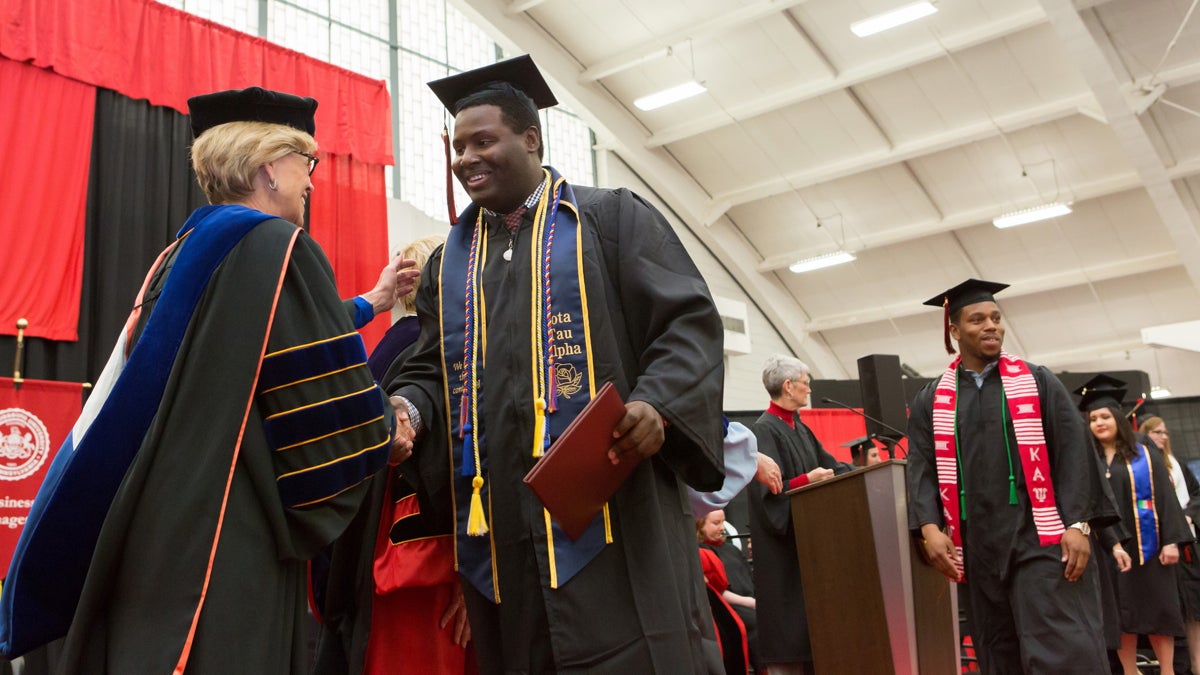At many Pa. colleges, black students are not benefiting amid rising graduation rates

Students accept their diplomas at the 2016 spring commencement at East Stroudsburg University. The school has succeeded in narrowing the graduation gap between black and white students while boosting minority enrollment. (East Stroudsburg University)
A recent study finds graduation rates at four-year colleges and universities in the U.S. have risen in the last decade — but the gap between the number of white and black students graduating has actually widened.
The study, conducted by the Education Trust, found that overall institutional improvement doesn’t equal gains for underrepresented minorities, particularly black students.
Latino and Native American students made more rapid progress toward increased graduation rates than white students, while black students lagged.
Nearly 69 percent of the institutions sampled showed improvement for black students, but not enough to close the gaps between black and white students. And 31 percent of the schools showed no gains for black students.
Marybeth Gasman, director of the University of Pennsylvania’s Center for Minority Serving Institutions, said schools that have managed to close their retention and graduation gaps have taken similar approaches.
“They have peer mentoring,” she said. “They have students’ success centers, and they have some kind of data-tracking app. And with those three things together, you can do an amazing amount of good and really propel students toward graduation.”
While some schools may want to blame student inadequacies for graduation rates, the study also takes into account levels of student preparation and an institution’s lack of resources. Researchers point out the variety of graduation rates among schools that enroll the same types of students demonstrates that what institutions do for students matters.
A companion study found successful schools enrolled more minorities; addressed completion inequities; and increased the graduation rate of minority students.
East Stroudsburg University in Pennsylvania and New Jersey’s Rutgers University-Newark were singled out as models for closing the gaps.
Changes at East Stroudsburg
A decade ago, East Stroudsburg’s student body was 9 percent minority. Today, students of color make up a third of the enrollment.
The school has closed its graduation gap between white and minority students by nearly 8 percent, from 24 percent down to 16 percent.
Storm Heter, co-director of the university’s Race Relations Project, said one reason is its increase in diversity. The fall 2016 class consists of 46 percent minority students.
“We think one of our successes is not only that we’ve closed the graduation gap between black and white students — or we’re closing in on it — but that we have increased the number of underrepresented students dramatically at ESU,” he said.
Student-centered programs are part of their success, Heter said.
“We find that those students are more engaged,” he said. “They stay around. We retain them better. They get practical life experience, and they learn that actually they are each other’s best resource.”
The university also offers the Race Relations Project, which brings students together to talk about diversity, as well as small groups of students from different backgrounds to have open dialogues.
“From my research, what I’ve seen is that having the bodies at an institution isn’t enough for diversity to become a part of the culture,” Heter said. “So what we’ve done at ESU is we’ve really worked to try to make diversity part of our culture and part of who we are as an institution.”
Widening gaps at other Pa. colleges
Part one of the study found Pennsylvania state system universities Millersville and Kutztown on the list of institutions that are improving their overall graduation rate — but with widening racial gaps and declining graduation rates for black students in the past 10 years.
Gasman said she sees common threads at institutions with widening gaps.
“A lot of times, they’re under-resourced and people have too many jobs, and so students can slip through the cracks,” she said. “Sometimes, they’re really, really big, and their systems don’t allow for much individuality among students.
“Sometimes, they operate as if all of their students are the same, and you can’t operate that way. You have to realize that all your students are really different people, come from very different backgrounds.”
Kutztown had a 5-point gap a decade ago and that gap is now more than 20 percentage points.
Of the 14 universities in the state system, 10 widened the gap or stayed the same. In addition to East Stroudsburg, only Shippensburg and Slippery Rock decreased the graduation gap. Cheyney, because it’s a historically black university, was not included in the study.
Temple University and the University of Pittsburgh graduation gaps stayed the same, while Penn State decreased its gap by 2 percent.
While the state system is large, Gasman said, it isn’t impressive.
“I’m saying that because I don’t think that it’s innovative,” she said. “I think that they do a good job of educating a large number of people, but in order to really speak to the modern-day student, you have to keep your innovation game up. And I don’t see that.”
It’s important for the state system to look at East Stroudsburg and see what officials are doing there, she said. They could become the role models for other universities in the system, she said.
WHYY is your source for fact-based, in-depth journalism and information. As a nonprofit organization, we rely on financial support from readers like you. Please give today.




